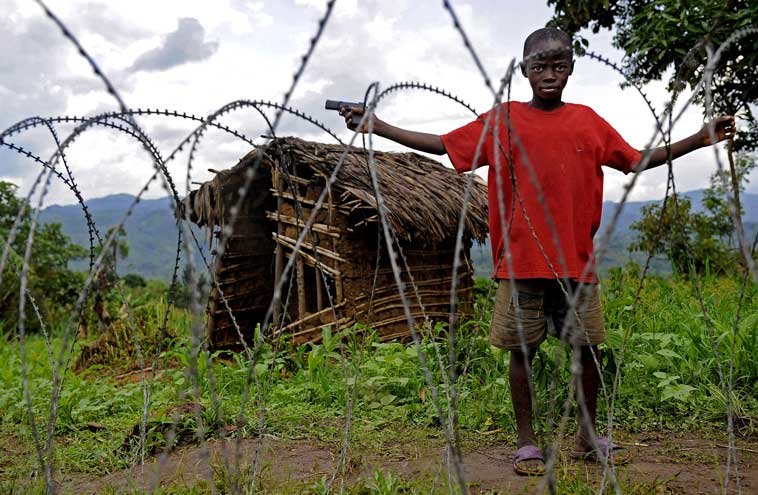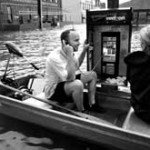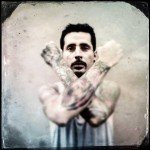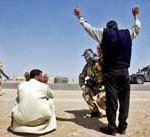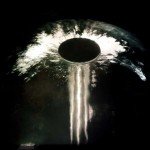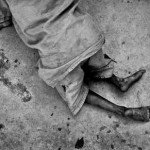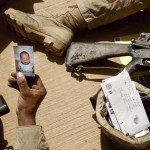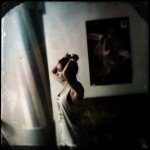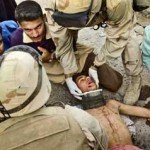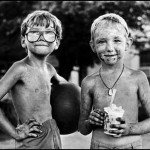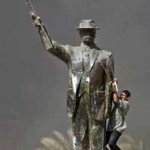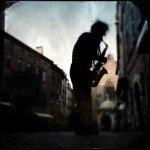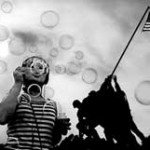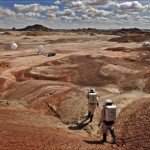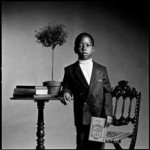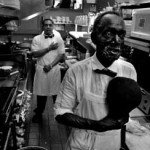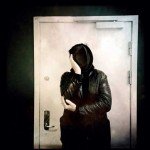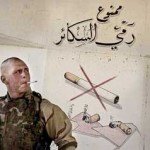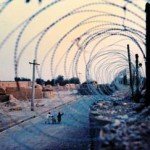+ By Tom Levine
 On a Friday afternoon this past July, Joe Eddins spoke about the photographs he shot in 2003, at the onset of the Iraq war. Eddins, who was a Washington Times staff photographer at the time, had accompanied a marine battalion as it ascended a berm just over the Kuwaiti border and began a march across the barren Iraqi landscape.
On a Friday afternoon this past July, Joe Eddins spoke about the photographs he shot in 2003, at the onset of the Iraq war. Eddins, who was a Washington Times staff photographer at the time, had accompanied a marine battalion as it ascended a berm just over the Kuwaiti border and began a march across the barren Iraqi landscape.
Eddins’ photographs show young soldiers bearing the burden of their mission—their faces unable to mask emotional turmoil, their bodies slumped in physical exhaustion. One soldier crouches behind a sandy embankment with three others: he looks up, beyond the camera, his eyes wide, alert, and with a touch of fear. The shot is real and dramatic. Another photo shows the surrealism of war: four soldiers enjoying a card game, their bodies relaxed and their heads enshrouded in gas masks.
The images are clear, sharp, and economical. They present stories that we would not have otherwise seen, one frozen moment at a time. Somehow Eddins shows us—through digitized conversion of light and shadow—something real about the human experience.
 When Eddins’ father served in World War II, he took along a boxy Kodak Brownie Hawkeye camera. “His photographs from his airplane of the Pyramids at Giza, the Himalayas, his crew, and [his] pet monkey in India really put the hook in me,” says Eddins. “As a kid, I could be seen running around, looking through the viewfinder and clicking the shutter on that very same camera, even though there was no film in it.” While studying journalism at West Virginia University, he enrolled in an elective course in photography. By the next semester, he seemed to be spending half his time snapping pictures and the other half in the darkroom. Immersed in photography, Eddins barely made it to class. Without the help of a friend who taped lectures, he might still be working through his senior year.
When Eddins’ father served in World War II, he took along a boxy Kodak Brownie Hawkeye camera. “His photographs from his airplane of the Pyramids at Giza, the Himalayas, his crew, and [his] pet monkey in India really put the hook in me,” says Eddins. “As a kid, I could be seen running around, looking through the viewfinder and clicking the shutter on that very same camera, even though there was no film in it.” While studying journalism at West Virginia University, he enrolled in an elective course in photography. By the next semester, he seemed to be spending half his time snapping pictures and the other half in the darkroom. Immersed in photography, Eddins barely made it to class. Without the help of a friend who taped lectures, he might still be working through his senior year.
Whether on a beach in Bermuda, catching the wide-eyed excitement of race fans at Pimlico, or in the middle of a war zone, Eddins’ focus has always been on capturing the image. During more dangerous assignments, the intensity of his job and his focus left no time for concern about personal safety—at least until nighttime, when he switched off his camera. While in Iraq, sleep came fitfully at best. It was the only time when anxiety found a toehold, as the fear of chemical weapons hung heavily in the air. “We were absolutely sure that we were going to get slimed at some point,” says Eddins. The thought would wake him, sweating in the middle of the freezing desert night.
Mary Calvert met Eddins at the Washington Times in 1998, when she was hired as a staff photographer. They began dating soon after, and were married in 2001. During their idyllic honeymoon in Kauai, they had so successfully unwired themselves that they did not hear about the events of September 11, until six hours after they occurred.
 Calvert was assigned to cover the war when it shifted to Afghanistan. She was on a helicopter with a medevac team as it flew into live war zones to treat and evacuate wounded and dying troops. The conditions were so hazardous that the helicopter could only touch down on one wheel, hovering inches above the ground, for fear of setting off land mines. Her pictures clearly show that she never flinched in perilous situations. During our interview, when she excused herself for a few moments, Eddins leaned in towards me and said, “Now that she’s not here and can’t respond—she is an incredibly brave woman.”
Calvert was assigned to cover the war when it shifted to Afghanistan. She was on a helicopter with a medevac team as it flew into live war zones to treat and evacuate wounded and dying troops. The conditions were so hazardous that the helicopter could only touch down on one wheel, hovering inches above the ground, for fear of setting off land mines. Her pictures clearly show that she never flinched in perilous situations. During our interview, when she excused herself for a few moments, Eddins leaned in towards me and said, “Now that she’s not here and can’t respond—she is an incredibly brave woman.”
While in college, Mary Calvert considered a number of careers. She was a liberal arts major who studyied travel and tourism, mental health, fine art photography, and commercial photography before returning to fine art. One winter day in 1981, she went to a matinee with her mother, and as they left the theatre they learned that Ronald Reagan had been shot. She went home, grabbed her camera, and headed over to George Washington University Hospital in DC, where the president was being treated. She found herself outside of the emergency room, hanging out with A-list photojournalists, a group who by that time had finished taking their pictures and had taken up their second-favorite activity: swapping war stories that were of shaky provenance but had solid entertainment value. “I was hooked,” she says.
 During her job at the Washington Times, Calvert always looked for the iconic shot, the picture that showed the threads that bind us together, notwithstanding our differences. Her picture of cook Tom Hall, pausing to recite the Pledge of Allegiance at Chick & Ruth’s Delly in Annapolis, is a perfect example. Like much of her work, the shot is in black and white. Hall is turned away from the griddle, eyes gazing upward, hat held over his heart. With his grizzled, wiry beard, sinewy arms, and glossy skin, Hall appears sculpted in a deeply patinated bronze. His expression is humble, yet the image is heroic. It’s a short story about ritual and patriotism, showing how extraordinary the ordinary can be.
During her job at the Washington Times, Calvert always looked for the iconic shot, the picture that showed the threads that bind us together, notwithstanding our differences. Her picture of cook Tom Hall, pausing to recite the Pledge of Allegiance at Chick & Ruth’s Delly in Annapolis, is a perfect example. Like much of her work, the shot is in black and white. Hall is turned away from the griddle, eyes gazing upward, hat held over his heart. With his grizzled, wiry beard, sinewy arms, and glossy skin, Hall appears sculpted in a deeply patinated bronze. His expression is humble, yet the image is heroic. It’s a short story about ritual and patriotism, showing how extraordinary the ordinary can be.
The Washington Times gave Calvert entrée to the powerful and the mighty, and she produced intimate views of US presidents and others in Washington’s echelons of power. It also gave her the freedom to pursue what moved her: long form photojournalism. “I specialize in underreported or neglected stories about gender-based human rights issues. We used to call this type of work ‘women’s issues,’” says Calvert. “I prefer to think of them as our issues.” She explains that marginalizing half the world’s population creates a problem for all of us. “The only difference between ‘us’ and ‘them’ is that they were born there, and we were born here. I became a photojournalist so I could tell the stories of those with no voices and provide a mirror for society to examine itself. Everyone should know what is going on in his or her world, and it is my job to make them care.”
In 2007, Calvert was nominated as a finalist for the Pulitzer Prize in feature photography for project, “Ethiopia’s Trail of Tears,” a work described as a haunting depiction of sub-Saharan African women afflicted with fistula after childbirth. She earned her second Pulitzer nomination in 2010, for “Congo’s War on Women” for her “courageous work published in the Washington Times that vividly documents how rapes, by the tens of thousands, have become a weapon of war in Congo.” Shortly after, the Washington Times downsized and Calvert was laid off. She spent a year redirecting her career, becoming an independent photographer.
Desiring to contribute to family finances, she began expanding her work assignments to include corporate shoots and second shooter gigs for wedding photographers. Her independent work kept her tied into Washington’s political spheres, getting her occasional bylines in publications such as the New York Times.
After Eddins was laid off from the Washington Times in 2013, he and Calvert began applying for and receiving grants that allowed them to conceive and produce their own works. They conceived of longer feature pieces that required research, commitment, and vision. Work like Calvert’s series on sexual assault in the military.
 Eddins had shocked Calvert with the statistic that 26,000 sexual assaults occurred in the military in one year alone. Calvert had spent years covering the military in Washington and in the battlefield, and had taught photography to military photographers for over a decade. It was a story that hit close to home. She created a two-part piece. The first part presents photographs of sexual assault victims. The second part documents the government’s response—there is a long shot inside a congressional hearing room whose architecture reflects the classical ideals of democracy; a woman sits at a table, testifying, and across from her are rows of empty seats, presenting a strong image of institutional indifference.
Eddins had shocked Calvert with the statistic that 26,000 sexual assaults occurred in the military in one year alone. Calvert had spent years covering the military in Washington and in the battlefield, and had taught photography to military photographers for over a decade. It was a story that hit close to home. She created a two-part piece. The first part presents photographs of sexual assault victims. The second part documents the government’s response—there is a long shot inside a congressional hearing room whose architecture reflects the classical ideals of democracy; a woman sits at a table, testifying, and across from her are rows of empty seats, presenting a strong image of institutional indifference.
Winding down from such intense work is not difficult for the couple. “When we are off work, we tend to be very laid back,” says Calvert. They hang out with family and friends, eat out, go for walks, and share one other passion: baseball. It provides the pure green field where everything is ordered and nothing happens that is worse than a stolen base (except for a loss by the Orioles or the San Francisco Giants; they are strictly an orange-and-black family). A trip to the ballpark is one of their great pleasures. But it also reminds them how hard they have had to work to do what they do.
Tenney Mason was the director of photography at Patuxent Publishing in Columbia, Maryland, when Eddins began his career there. Eddins considers Mason his mentor, and remembers advice given to him about dedication and patience. “[Mason] equated documentary photography to hitting in baseball. You have to train hard and make no money for a long time, invest a huge amount of time away from your family and friends, and accept the fact that you fail more often than not,” recalls Eddins. “But if you play long enough and only fail two-thirds of the time, you have a shot at doing something special.”
As artists, Eddins and Calvert strive to make strong and vivid images that show us something we’ve never seen before, take us somewhere we’ve never been, and speak to us on an emotional level. They want to refocus our attitude about the world. Sometimes it’s staggeringly beautiful, like Eddins’ shot of the aurora borealis in the Norwegian sky, and other times it is austere, making us aware of the plight of others. They are each other’s most trusted, honest critics, providing ideas and inspiration. Their courage, drive, and support are never more evident than when one is leaving for a hostile corner of the world, and the other smiles and says, “Be safe, honey.” █

